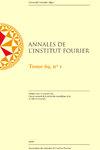Vanishing cohomology and Betti bounds for complex projective hypersurfaces
IF 0.7
4区 数学
Q2 MATHEMATICS
引用次数: 3
Abstract
We employ the formalism of vanishing cycles and perverse sheaves to introduce and study the vanishing cohomology of complex projective hypersurfaces. As a consequence, we give upper bounds for the Betti numbers of projective hypersurfaces, generalizing those obtained by different methods by Dimca in the isolated singularities case, and by Siersma-Tibăr in the case of hypersurfaces with a $1$-dimensional singular locus. We also prove a supplement to the Lefschetz hyperplane theorem for hypersurfaces, which takes the dimension of the singular locus into account, and we use it to give a new proof of a result of Kato.复射影超曲面的消失上同调与Betti界
利用消失环和反常束的形式引入并研究了复射影超曲面的消失上同调。因此,我们给出了射影超曲面的Betti数的上界,推广了Dimca在孤立奇点情况下用不同方法得到的结果,推广了siersma - tibrure在1维奇异轨迹超曲面情况下用不同方法得到的结果。我们还证明了考虑奇异轨迹维数的Lefschetz超平面定理对超曲面的补充,并利用它对Kato的一个结果给出了新的证明。
本文章由计算机程序翻译,如有差异,请以英文原文为准。
求助全文
约1分钟内获得全文
求助全文
来源期刊
CiteScore
1.70
自引率
0.00%
发文量
92
审稿时长
1 months
期刊介绍:
The Annales de l’Institut Fourier aim at publishing original papers of a high level in all fields of mathematics, either in English or in French.
The Editorial Board encourages submission of articles containing an original and important result, or presenting a new proof of a central result in a domain of mathematics. Also, the Annales de l’Institut Fourier being a general purpose journal, highly specialized articles can only be accepted if their exposition makes them accessible to a larger audience.

 求助内容:
求助内容: 应助结果提醒方式:
应助结果提醒方式:


